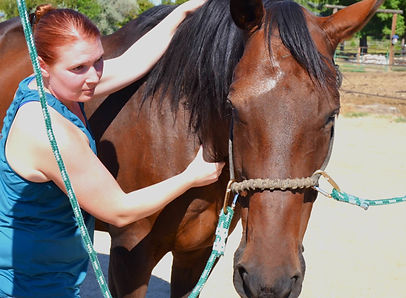

Equine Bodywork
Services

I use a variety of bodywork methodologies depending on each individual horse, and I often utilize multiple therapies to tailor each session for the horse. Read on to see the services I offer and the types of bodywork you might see me use during a session.
What to Expect
A typical bodywork session can last between 30 to 60 minutes, with most falling around 45 minutes. The length of the session depends on the horse's needs and tolerance. The first bodywork session often runs a little long so I can get to know you and your horse better.
I offer the following forms of therapy, and I tailor every session for what the horse needs and wants.
*Please note: Additional charges may apply for oversized horses, difficult horses, or driving distances greather than 45 minutes from Eagle, ID.
Gait Analysis
All equine bodywork is rooted in biomechanics. Biomechanics refers to the physics of how a body's structures interact with one another to create movement. If movement is incorrect or incomplete, there may be a physical problem that can be addressed via bodywork. However, before we can get to the bodywork, we must first observe how the horse is moving. This is where a gait analysis based on biomechanics comes in. Recognizing what correct movement looks like can help us to pinpoint sources of stiffness and discomfort in our horses that might be addressed through bodywork. I do a gait analysis prior to every bodywork session.


Equipment Evaluations
We all know how important it is to have an appropriately fitting saddle to ride in. That's a great start, but many of us stop there. In fact, every human-made item that touches your horse can impact their performance. This includes bridles and bits, boots, driving harnesses, and more. I can assist with evaluating and advising on correct tack fit and function. When your horse can move with comfort and natural freedom, he will deliver his best.
Equinology Approach
I earned my certification through the Equinology Institute, and I value this form of therapy as a means of singling out particular muscles or muscle groups that need attention. The Equinology Approach, developed by Debranne Pattillo, integrates various techniques like sports massage, soft-tissue mobilization, and muscle activation to support a horse's entire body. It emphasizes anatomical precision and ongoing learning, making it a highly regarded method among equine professionals worldwide.


Trigger Point Massage
Trigger point therapy is a massage technique that targets muscle knots and tension to alleviate pain and improve flexibility. By applying pressure to specific trigger points, we can release tightness in muscles and fascia, which can reduce pain, enhance flexibility, and decrease stress levels. This form of therapy is useful for a wide range of horses, but I find it most effective for performance horses in medium to heavy work.
Bowen Therapy
Bowen therapy is a gentle form of bodywork that involves precise, rolling hand movements on the fascia, muscles, tendons, and ligaments to promote pain relief and stimulate the nervous system. This therapy aims to activate the parasympathetic nervous system for relaxation. I have found Bowen therapy to be effective for a variety of situations, including senior horses with limited mobility and sport horses in regular work. But it has a particularly powerful effect on horses that are dull or 'shut down'.


Lymphatic Massage
Lymphatic massage is a massage technique designed to relieve swelling caused by lymphedema. By manipulating specific areas of the body, this massage helps move lymph fluid to areas with functioning lymph vessels, reducing swelling and discomfort. While this type of massage may benefit horses in recovery from injury or surgery, I have found it to have more general uses too, especially for horses that spend significant amounts of time in confinement or those that suffer from seasonal allergies.
Fascial Stretching
Fascial stretch therapy (FST) is quickly becoming one of my new favorite things. FST is a specialized system of assisted stretching that focuses on fascia and joint mobility. It uses a combination of traction, oscillation, and circumduction to release deep tissue tension and relax the nervous system's hold on tissues. I have personally experienced profound relief from chronic nerve pain through FST, which inspired me to learn more and apply it to my horses. While I am still new to this form of therapy in equines, I have found it to be beneficial for a variety of situations, particularly for horses that experience chronic lumbar pain.
